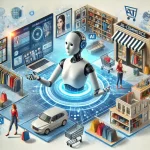Speech recognition and natural language processing (NLP) are two fundamental technologies that have enabled artificial intelligence (AI) to bridge the gap between humans and machines. These technologies allow AI systems to understand, interpret, and generate human speech, making interactions with digital assistants, chatbots, and automated systems more natural and seamless. From voice-activated devices like Alexa and Siri to complex language models like GPT, AI has made remarkable progress in the field of language understanding and speech generation. In this article, we will explore how AI systems process speech and language, the technologies behind these advancements, and the challenges that remain.
The Basics of Speech Recognition
Speech recognition is the process by which AI systems convert spoken language into text. This involves several key steps, including capturing audio, processing the sound waves, and using algorithms to match speech patterns with words and phrases. The goal of speech recognition is to enable machines to “hear” and understand spoken language, allowing for hands-free interaction with technology.
At the core of speech recognition technology is a combination of acoustic models, language models, and signal processing techniques. Acoustic models help the AI system recognize the fundamental sounds (phonemes) in a language, while language models predict the likelihood of certain word sequences. By combining these models, AI systems can accurately transcribe speech into text.
One of the earliest examples of speech recognition technology was IBM’s “Shoebox,” which debuted in the 1960s. It could recognize and respond to a limited set of spoken digits and arithmetic commands. Since then, advances in machine learning, deep learning, and computational power have dramatically improved the accuracy and scope of speech recognition systems. Today, speech recognition technology is embedded in smartphones, smart speakers, and various software applications.
How Natural Language Processing (NLP) Works
Natural language processing (NLP) is the field of AI that focuses on enabling machines to understand, interpret, and generate human language. Unlike speech recognition, which focuses solely on converting audio into text, NLP goes a step further by allowing machines to comprehend the meaning and context of that text.
NLP involves several key tasks, including:
Tokenization: Breaking down a piece of text into smaller units (words or phrases) that the AI system can analyze.
Syntax Parsing: Analyzing the grammatical structure of a sentence to understand how words relate to each other.
Sentiment Analysis: Determining the emotional tone or sentiment behind a piece of text, such as whether a review is positive or negative.
Named Entity Recognition (NER): Identifying and categorizing proper nouns, such as names of people, organizations, and locations.
Machine Translation: Translating text from one language to another using AI models.
The most advanced NLP systems rely on deep learning models, particularly transformer architectures, to process and generate human language. Transformer-based models, such as OpenAI’s GPT and Google’s BERT, are designed to capture the relationships between words and phrases in a given context. These models can generate coherent, contextually relevant text, making them useful for tasks such as text generation, summarization, and conversation simulation.
Speech-to-Text and Text-to-Speech Technologies
AI systems use two complementary technologies to facilitate natural language interaction: speech-to-text (STT) and text-to-speech (TTS).
Speech-to-Text (STT): Speech-to-text technology converts spoken language into written text. This is commonly used in voice recognition systems like Apple’s Siri or Google’s Assistant. Once speech is converted to text, NLP algorithms process the text to understand the user’s intent and respond accordingly.
Text-to-Speech (TTS): Text-to-speech technology converts written text into spoken language. TTS is commonly used in applications like screen readers for the visually impaired, audiobook generation, and voice-enabled customer service systems. Modern TTS systems, powered by AI, are capable of generating speech that mimics natural human intonation, making interactions feel more authentic.
TTS relies on sophisticated neural networks that generate human-like voices from textual input. These systems are trained on large datasets of recorded speech, enabling them to produce natural-sounding speech with appropriate tone, rhythm, and emphasis.
Language Models and AI-Driven Text Generation
One of the most groundbreaking advancements in NLP has been the development of large-scale language models, such as GPT (Generative Pre-trained Transformer) and BERT (Bidirectional Encoder Representations from Transformers). These models are designed to process vast amounts of text data, learn linguistic patterns, and generate coherent text based on context.
GPT models, for example, have been trained on diverse datasets that include books, articles, and websites. These models can generate human-like text that is contextually relevant, making them useful for a wide range of applications, from automated content creation to chatbot conversations.
How Language Models Generate Text: Language models like GPT work by predicting the next word in a sequence of text based on the words that precede it. These models use a technique called “attention,” which allows them to weigh the importance of each word in a sentence and generate coherent responses. For instance, when generating a response to a user’s query, the model considers the context of the entire conversation to provide a relevant and meaningful answer.
Applications of AI Text Generation: AI-driven text generation has found applications in numerous fields, including:
Chatbots: Virtual assistants and customer service bots use NLP and language models to engage in natural conversations with users.
Content Creation: AI can assist in writing articles, blog posts, and even creative works such as poems and stories.
Translation: Language models are used to translate text between languages with increasing accuracy, reducing the need for human translators.
Summarization: AI systems can automatically generate summaries of long texts, helping users quickly understand the key points of an article or report.
Challenges in Speech and Language Understanding
Despite the rapid advancements in speech recognition and NLP, there are still significant challenges that AI systems must overcome to fully replicate human-level language understanding.
Ambiguity and Context: Human language is often ambiguous, with words and phrases having multiple meanings depending on the context. AI systems must be able to accurately interpret this context to generate appropriate responses. While large-scale language models have made progress in this area, understanding the nuances of human speech remains a challenge.
Dialects and Accents: Speech recognition systems sometimes struggle to accurately transcribe speech from individuals with diverse accents or dialects. AI systems need to be trained on a wide variety of speech patterns to be truly effective for global use.
Ethical Considerations: AI language models can sometimes generate biased or inappropriate responses if they are trained on biased datasets. Ensuring that AI systems are fair and unbiased in their language generation is a key challenge that researchers continue to address.
Conclusion
Speech recognition and natural language processing are at the forefront of AI’s ability to understand and generate human speech. From transforming spoken language into text to creating conversational AI that can generate coherent and contextually relevant responses, these technologies are revolutionizing how we interact with machines. As AI continues to advance, the potential applications for speech and language understanding will expand, enabling more intuitive and natural interactions between humans and machines. However, challenges related to context, ambiguity, and ethical considerations must be addressed to fully realize the potential of AI-driven speech and language technologies.



Oh, I’ve already seen these special glasses for the hearing-impaired that show speech as text right in front of your eyes! It’s amazing!
yeah dude how amazing is that!
dude.. people speaks about this… 5 or 6 years?
As tech improves, expect even smoother interactions! So excited to see whats coming up next
AI talks now?! 🗣️🤖 Voice recognition is getting scary good! Future’s talking back. Context is key! 🤔
speech recog & nlp? always listening tho?! 😱😱
speech AI so buggy🤔 ai will never be human
lol AI speech is fire 🔥 but fails sometimes 👎